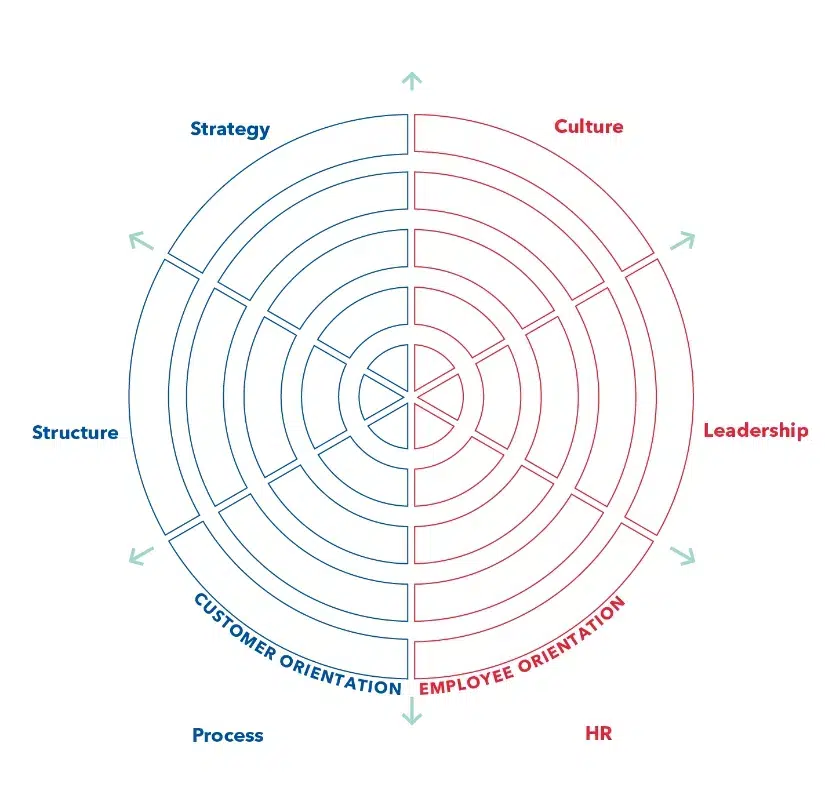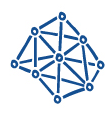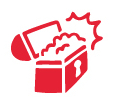Many companies that work with agile process models see challenges in the way they work agile and use agile process models after some time. The symptoms vary, but the challenges are mostly perceived in the process dimension. And mostly the companies try to solve the problems in the process dimension as well. However, our experience has shown that the causes of the challenges of agile process models often are located in other dimensions. After all, agility is not a process or a method, but a completely different form of business management.
This is why we have developed the Pioneers Trafo-ModellTM. It gives you orientation on which dimensions you need to look at your company if it is to become more agile:
Strategy
Companies are often driven by the need to increase shareholder value and achieve corresponding performance indicators. This forces companies to get as much as possible out of their employees and customers. However, in a world where customers and employees are increasingly offered good alternatives, this approach leads to a downward economic spiral in the long run. I will only survive in a turbulent market if I put the needs of customers and employees at the centre. At the same time, in an agile organisation based on self-organisation, I need orientation. Without knowing the famous North Star, I cannot take responsibility and make decisions as an employee. No key figures to be achieved will help; I need to know who we are, what our vision and mission are – and for whom we create added value.
We are happy to support you in developing a customer-centred strategy at company, division and team level. Here we run through a complete strategy cycle with you, consisting of
- Location analysis
- Future development
- Deriving strategies and tactics
- Setting up a continuous implementation and reflection process.
We are also happy to support you in individual modules and help you, for example, …
- identify the why
- research and prioritise personas
- develop a customer journey, analyse the touchpoints and identify fields of action
- Create a customer value analysis
- Run a Design Thinking Sprint
- develop a strategy canvas (e.g. a business model canvas)
- set up a flight level system (also called “priority boards”)
- Set up OKRs in an agile way
Structure
Many companies are functionally divided. By bundling expertise, one can save manpower and utilise it efficiently according to the principle of “economy of scale”. For most functions, this results in a loss of customer focus and an understanding of the value creation process. Divisional egoisms and self-management often take over. Due to the simultaneously pyramidal organisational form, I work for my manager, not for the customer. It is also important to establish the customer as the new boss through the organisational structure and at the same time to enable focused cooperation throughout the entire value creation process.
We are happy to support you at company and divisional level to build a cross-functional, customer-centric structure, e.g. by guiding you through an organisational design sprint.
Process
Especially in the area of processes, we have a big lever to become operationally faster and more customer-centred. We no longer try to plan the unplannable, to decide everything top-down, to do everything at once and to make decisions forever. For complex challenges, we analyse and plan in very short cycles and build in regular reflection formats for learning and redirecting. We establish principles instead of rules, delegate responsibility downwards and enable self-organised teamwork end-to-end.
We are happy to support you at company, departmental and team level in building processes that promote speed, e.g. by working with you to…
- setting up priority boards at the strategic, tactical and operational level with or without OKR system and scaling cooperation
- setting up a continuous strategy and innovation process
- Set up meeting structures across departmental boundaries in the sense of end-to-end thinking and develop an efficient meeting culture, e.g. with the help of the Pioneers Navigator cards.
- Guide teams through the first steps towards self-organisation and cooperation with stakeholders.
- Put rules to the test
HR
Human Resources is one of the first central functions with which a company becoming more agile comes into conflict (others will follow …). At the same time, it is the department with the most complex need for change. HR, too, must say goodbye to wanting to regulate complex issues in general and to exercise governance in the company if it wants to support the company in working quickly and centred on the customer. On the technical issues, HR will move more into an advisory role, allowing teams to build their own HR that suits them. At the same time, HR brings valuable competences for supporting an agile transformation and can move the company forward in the role of change agent and transformation coach. This automatically raises the question of how HR should work and organise itself in the future.
We support you in your HR department to position yourself centred on the operational teams, e.g. by working with you to …
- finding your new role as an HR department
- developing your processes and tools in such a way that they promote the agility of the company: e.g. career, role and competence models, performance management, talent management, recruiting, feedback systems, salary systems
- develop a new structure for your HR department
- check how you can work in agile processes yourself
- by acting as a neutral third party to raise awareness with your works council.
Leadership
To become faster, I have to hand over responsibility downwards and enable self-organisation. Leadership tasks therefore move away from the traditional managers to the employees. In many companies, it has proven successful to distribute leadership responsibility among different roles, which, however, do not have disciplinary power over each other, but meet at eye level. The best-known model is proposed by Scrum, with product owner, Scrum master and team. The Spotify model is also currently the subject of much discussion. Here, however, it is worthwhile to look individually at what currently makes sense in your company.
We support you in becoming self-organised at company, department and team level, e.g. by …
- supporting the existing leadership role holders from the managing director to the team leader in becoming agile leaders through impulses, workshops and individual coaching
- developing the top management team into an agile team
- launch the Agile Challenge in your company’s corporate design for your leaders
- develop a new leadership model with possibly new roles, but certainly new role descriptions and promote the understanding of roles in the company
- develop and apply the selection process for the new roles, e.g. with the help of an Agile Collaboration Day
- Train the new leadership roles for the agile environment and provide initial support.
- Initialise communities for the new leadership roles
Culture
And in the end, it’s all about cultural development, because agility is first and foremost a conglomerate of values and principles. Only when I start to understand my company as a big team that works together end-to-end for the customer will I pick up speed. My company will only quickly become adaptable to the market if everyone starts to take responsibility – and is allowed to do so. If I reduce bureaucratic, controlling rules and allow trust to prevail – and if I allow trial and error. This is a question of attitude and human nature that can only be developed step by step.
We support you in developing a culture of networking, trust and learning at company, department and team level, e.g. by …
- holding playful (large group) events to introduce you to agility
- developing your desired culture collaboratively, e.g. with the help of the Pioneer Cards
- give you tools to analyse aspects of your current culture and work towards your desired culture
- by mediating in conflicts
- developing feedback systems with you
- establishing appreciation mechanisms
- guiding formats for building trust, networking and learning with each other in the company
Further information
As a rule, there are always dimensions in which a company is already further advanced – consciously within the framework of an agile transformation or unconsciously because it is part of the corporate culture. And dimensions that are less developed towards agility. These bottleneck dimensions prevent further progress if they are not addressed next and their maturity level is increased.
We developed the Pioneers Trafo-ModellTM in collaboration with Professor Stephan Fischer from Pforzheim University and there is of course much more to say about it.
You can find out more in our training courses for Certified Agile Transformation Manager, Certified Agile Leader or in our training on Agile organisational structures. You can also learn about the Trafo model in detail in our book Agile Organisations.
In the Pioneers Trafo Self-Check you will get an initial answer to what you can work on and where your levers are.
Do you have any questions? Feel free to contact Till directly and send him a message via the form.
Tillmann Seidel
Management Psychosoph
+49 221 84 68 10 99








